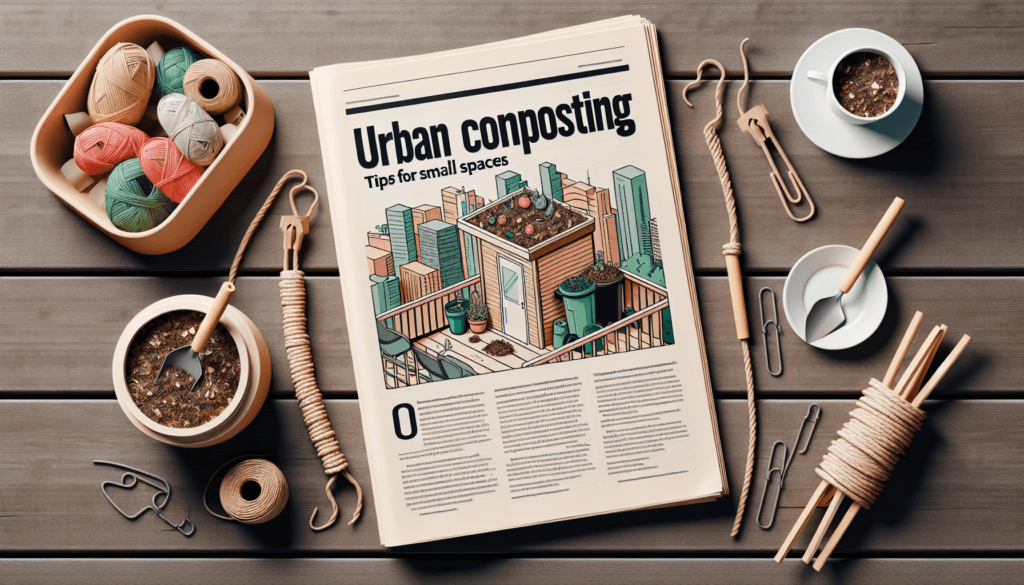Have you always wanted to try composting but thought it was impossible in your small urban space? Well, think again! Urban composting is not only possible, but it can also be incredibly rewarding. In this article, we will provide you with some valuable tips and tricks on how to successfully compost in small spaces. From choosing the right composting method to managing odors and space limitations, we have got you covered. Get ready to turn your urban living environment into a thriving ecosystem of nutrient-rich soil!

Choosing the right composting method
Open composting
Open composting is a traditional and popular method of composting that involves creating a pile of organic materials to decompose naturally over time. This method is suitable for larger outdoor spaces where you have the freedom to have an open compost pile. It is a simple and low-cost method, as you only need a designated area, such as a corner of your garden or yard, to start your compost pile. Open composting allows for the natural breakdown of organic materials and encourages the development of beneficial microbes and organisms in the compost pile.
Vermicomposting
Vermicomposting is a composting method that utilizes worms, specifically red worms or tiger worms, to break down organic waste. This method is well-suited for small spaces and can even be done indoors. Vermicomposting involves placing your organic waste in a worm bin along with bedding material such as shredded paper or leaves. The worms then consume the organic waste and produce nutrient-rich worm castings, also known as vermicompost. Vermicomposting is a great option for those who want to compost but have limited space or live in apartments.
Bokashi composting
Bokashi composting is a fermentation-based composting method that originated in Japan. It involves the use of a special bokashi bran that contains beneficial microorganisms to break down organic waste. Bokashi composting can be done in small spaces and even indoors as it is an anaerobic process that does not produce any foul odors. This method is ideal for composting all types of organic waste, including meat, dairy, and oily foods, which are not suitable for other composting methods. Bokashi composting offers a quick and efficient way to convert your organic waste into nutrient-rich compost.
Selecting a composting container
Size considerations
When selecting a composting container, it is essential to consider the size based on the amount of organic waste you generate. If you have a small household or limited space, a compact composting container would be more suitable. However, if you have a larger household or plan to compost a significant amount of waste, a larger-sized container would be necessary. It is important to choose a size that can accommodate your organic waste without overcrowding the container.
Materials
Composting containers come in various materials, such as plastic, metal, or wood. Each material has its advantages and considerations. Plastic containers are lightweight, durable, and affordable, but they may not be as aesthetically pleasing. Metal containers are sturdy and durable, but they can be prone to rust. Wood containers are attractive and blend well with outdoor spaces, but they may require more maintenance. Consider the pros and cons of each material and choose the one that best suits your needs and preferences.
Aesthetics
If you have limited space but still want to maintain the visual appeal of your composting area, consider a composting container that is aesthetically pleasing. Many composting containers now come in attractive designs and colors, allowing you to seamlessly incorporate them into your balcony, patio, or indoor space. Look for containers that have a sleek and modern design or ones that mimic the look of traditional planters to enhance the overall appeal of your composting area.
Odor control
One of the concerns when composting in small spaces is managing odors. To minimize unpleasant smells, choose a composting container that has a tight-fitting lid or cover. This will help seal in the odors and prevent them from escaping. Some composting containers also feature odor-neutralizing filters or charcoal liners that absorb and minimize odors. Additionally, consider using odor-absorbing materials such as sawdust or dried leaves to cover each layer of organic waste, further reducing any potential odors.
Locating the composting area
Balcony or patio
If you have limited outdoor space, your balcony or patio can serve as an ideal composting area. Look for compact composting containers or specialized composting systems designed for small spaces. Place the container in a corner or against a wall to maximize space utilization. Ensure that the area receives sufficient sunlight and is easily accessible for adding organic waste and turning the compost. Remember to consider any potential noise or odor concerns that may arise from composting in a shared living environment.
Indoor options
Composting indoors is an excellent option for those who have no outdoor space or live in apartments or condos. Indoor composting typically involves using a vermicomposting system or a bokashi composting system. These systems are designed to be compact and odor-free, making them suitable for indoor use. They can be placed under the sink, in a closet, or any other convenient location. However, it is essential to monitor the moisture levels and ensure proper ventilation to prevent any moisture buildup or odor issues.
Community composting
If you have limited space or are unable to compost at home, consider participating in a community composting program. Many cities now offer community composting initiatives where residents can drop off their organic waste at designated composting sites. These sites are often managed by the local government or non-profit organizations, ensuring that the composted materials are properly processed and utilized. Community composting is a great way to contribute to sustainable waste management and benefit from composting even in small spaces.
Maximizing composting efficiency
Mixing compost ingredients
To optimize composting efficiency, it is crucial to mix your compost ingredients properly. Layering your organic waste with dry materials such as leaves, shredded paper, or straw will help create air pockets and promote aeration within the compost pile. This is essential for the breakdown of the organic matter and the development of beneficial microorganisms. Additionally, periodically turning the compost pile will help mix the ingredients and ensure even decomposition. Aim for a balanced mix of green (nitrogen-rich) and brown (carbon-rich) materials to maintain optimal composting conditions.
Optimal compost pile size
The size of your compost pile can significantly impact the composting process. A compost pile that is too small may not generate enough heat for proper decomposition, while a pile that is too large may be difficult to manage or turn. As a general guideline, aim for a compost pile that is at least 3 feet in height, width, and depth. This size allows for efficient decomposition and optimal heat retention, ensuring that your organic waste breaks down effectively.
Maintaining proper moisture and aeration
Moisture and aeration are crucial factors in the composting process. Ensure that your compost pile is adequately moist, similar to a damp sponge. If it becomes too dry, add water to maintain the moisture levels. Conversely, if it becomes too wet, turn the pile and add dry materials to improve aeration and prevent excessive moisture buildup. Proper aeration is also essential for the composting process, as it allows air to circulate and promotes the growth of aerobic bacteria. Turning your compost pile regularly helps maintain proper aeration and ensures even decomposition.

Composting in small spaces
Small-scale composting options
When composting in small spaces, it is important to consider the scale of your composting system. Small-scale composting options include compact composting containers, vermiculture bins, or bokashi composting systems. These options are specifically designed for limited spaces and allow you to compost effectively without taking up too much room. Choose a composting method that aligns with your space constraints and the amount of organic waste you generate.
Using compost bins and tumblers
Compost bins and tumblers are popular options for small-space composting. Compost bins are enclosed containers with a hatch or opening at the bottom, making it easy to access the finished compost. Tumblers, on the other hand, are designed to be rotated, allowing for easy mixing and aeration of the composting materials. Both options help contain the compost, prevent pests, and minimize odor while providing efficient composting in a small space. Consider the size, design, and functionality of the compost bin or tumbler to find one that suits your needs.
Composting with limited space
If you have extremely limited space, consider alternative composting methods such as composting in pots or bags. This method is particularly useful for apartment dwellers or those with no outdoor space. Simply fill a large container, such as a pot or bag, with a mixture of organic waste and composting materials. Turn the mixture regularly, ensure proper moisture levels, and monitor the progress of decomposition. While composting in pots or bags may not yield as much compost as larger-scale methods, it still provides a solution for composting in small spaces.
Composting dos and don’ts
Do’s for successful composting
- Do mix green (nitrogen-rich) and brown (carbon-rich) materials to maintain a balanced compost pile.
- Do turn your compost pile regularly to promote aeration and even decomposition.
- Do monitor the moisture levels and maintain a damp but not overly wet compost pile.
- Do consider using a compost thermometer to monitor the temperature of your compost pile.
- Do add beneficial composting organisms, such as compost starter or finished compost, to accelerate the decomposition process.
Don’ts to avoid potential issues
- Don’t add meat, dairy, or oily foods to your compost pile, as they can attract pests and create odors.
- Don’t compost pet waste, as it may contain harmful pathogens that can contaminate the compost.
- Don’t use weeds or invasive plants in your compost pile, as they may spread and reestablish in your garden when you use the compost.
- Don’t overload your compost pile with too much waste at once, as it can slow down the decomposition process and create an imbalanced compost pile.
- Don’t use chemical additives or treated wood in your compost pile, as they may interfere with the natural decomposition process and contaminate the compost.

What to compost in small spaces
Fruit and vegetable scraps
Fruit and vegetable scraps are excellent additions to your small-space composting. These food scraps are rich in nutrients and break down relatively quickly, helping to create nutrient-rich compost. Collect the scraps in a countertop compost bin or keep them in the freezer until you’re ready to add them to your compost pile or vermicomposting system. Remember to chop larger scraps into smaller pieces to speed up decomposition.
Coffee grounds and tea bags
Coffee grounds and tea bags are another valuable addition to your compost. These organic materials contain nitrogen and add beneficial microbes to your compost pile. Coffee grounds can be added directly to the compost pile, while tea bags can be torn open and emptied into the pile. Both coffee grounds and tea bags help balance the carbon-to-nitrogen ratio in your compost and break down quickly.
Eggshells
Eggshells are a beneficial addition to your small-space composting. They provide a calcium boost to your compost, which is essential for healthy plant growth. Crush the eggshells before adding them to your compost pile to speed up decomposition. It’s important to note that only add eggshells from eggs that have been used in cooking or baking, as raw eggs may contain harmful bacteria.
Yard waste
If you have access to a small outdoor space, collecting and composting yard waste is a great way to supplement your small-space composting. Fallen leaves, grass clippings, small branches, and plant trimmings can all be composted. Shred larger materials, such as branches, into smaller pieces to facilitate decomposition. Ensure a good balance of green and brown materials by layering your yard waste with kitchen scraps to create a nutrient-rich compost.
What not to compost in small spaces
Meat, dairy, and oily foods
In small-space composting, it is best to avoid adding meat, dairy, and oily foods to your compost pile. These materials can attract pests and create foul odors. They also break down slowly and may not reach the high temperatures required for proper decomposition. Instead, consider alternatives such as bokashi composting, which allows for the composting of these types of organic waste.
Pet waste
Pet waste should not be composted in small-space composting systems. Pet waste may contain harmful pathogens and bacteria that can contaminate the compost and pose health risks. It is best to dispose of pet waste separately in designated waste bins or follow specific guidelines for pet waste disposal in your local area.
Weeds or invasive plants
While most plant materials can be composted, it is advisable to avoid adding weeds or invasive plants to your small-space composting. Weeds may contain seeds or root fragments that can survive the composting process and reestablish in your garden when you use the compost. Additionally, invasive plant species may spread and become a nuisance in your compost or garden. It is best to dispose of these plant materials separately or through other means recommended by your local waste management program.

Managing composting odors
Balancing carbon and nitrogen ratios
One of the key factors in managing composting odors is maintaining a balanced carbon-to-nitrogen ratio in your compost pile. This ratio is commonly referred to as the “browns to greens” ratio. Too much nitrogen-rich material, such as fresh grass clippings or kitchen scraps, can result in an overly wet and smelly compost pile. Adding more carbon-rich materials, such as dried leaves or shredded paper, can help absorb excess moisture and minimize odors.
Covering the compost pile
Covering your compost pile can also help control odors. Use a breathable material such as a tarp or a layer of straw to cover the compost pile. This helps retain moisture and heat while allowing airflow to prevent the buildup of unpleasant odors. However, ensure that the cover is not completely airtight, as the composting process requires proper ventilation.
Using effective odor-neutralizing agents
There are various odor-neutralizing agents that can be used to manage composting odors. These include adding layers of dry, odor-absorbing materials such as sawdust, dried leaves, or straw to your compost pile. Alternatively, you can sprinkle baking soda or a specialized composting odor control product designed to absorb and neutralize odors. Experiment with different techniques to find the odor control method that works best for your small-space composting.
Harvesting and using compost
Knowing when compost is ready
Compost is ready to use when it has turned into a dark, crumbly, and earthy-smelling material that resembles rich soil. The composting process can take anywhere from a few months to a year, depending on various factors such as the size of the compost pile, the materials used, and the environmental conditions. To determine if your compost is ready, look for signs like the disappearance of recognizable organic materials, the presence of earthworms, and a pleasant, earthy smell.
Using compost in container gardening
Compost is a valuable resource for container gardening in small spaces. Whether you have a balcony garden or a small urban garden, adding compost to your potting mix can significantly enhance plant growth. Mix compost with potting soil in a 1:1 ratio to provide a nutrient-rich medium for your plants. Additionally, top-dressing your potted plants with a thin layer of compost can help retain moisture and release nutrients over time, promoting healthy plant growth.
Benefits of compost tea
Compost tea is a liquid extract made from steeping compost in water. It is a nutrient-rich liquid fertilizer that can benefit plants in small-space gardening. Compost tea provides plants with a concentrated dose of beneficial microorganisms, essential nutrients, and organic matter. It can be used to water your potted plants or sprayed directly onto the foliage as a foliar feed. Regular application of compost tea can improve plant vitality, disease resistance, and overall plant health in your small-space garden.


